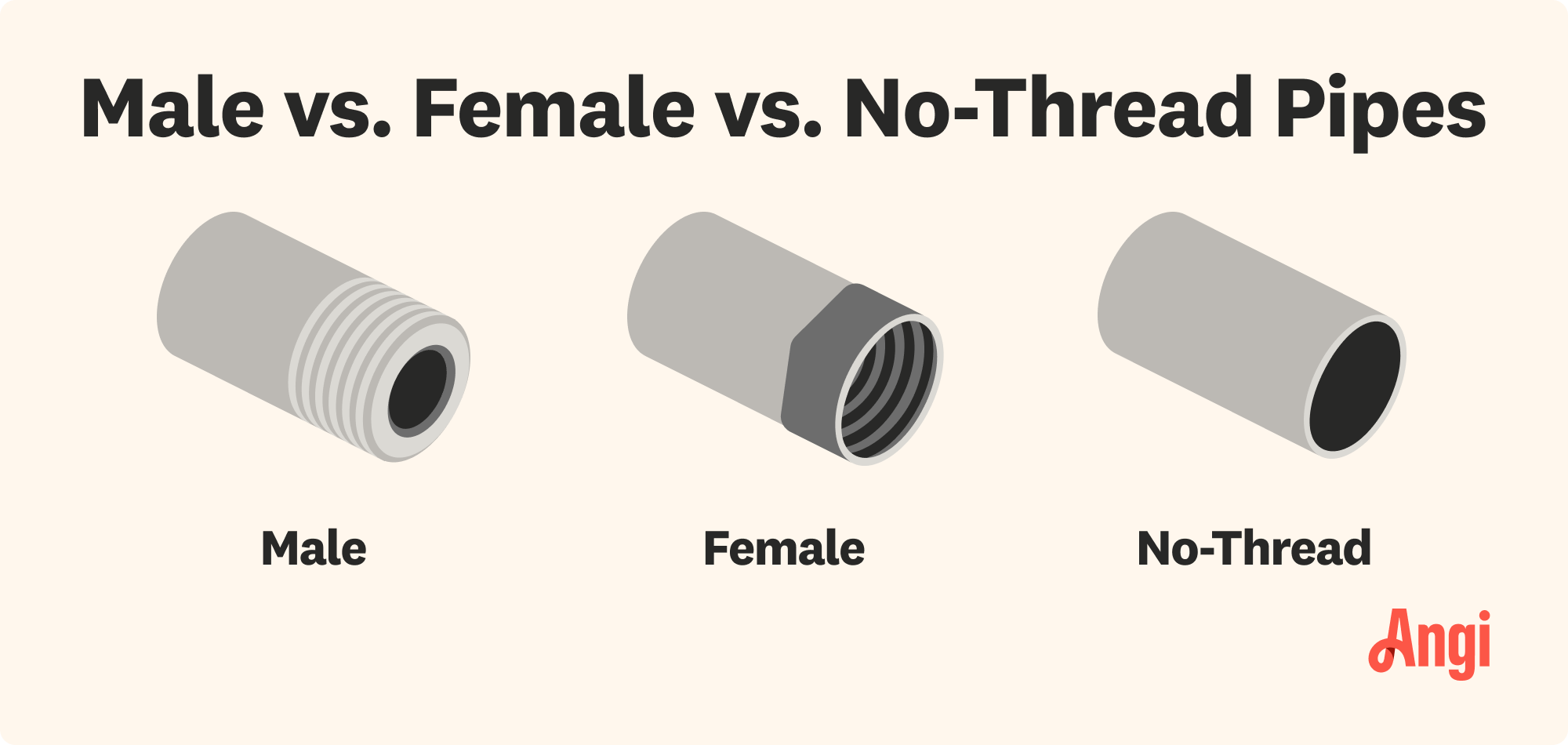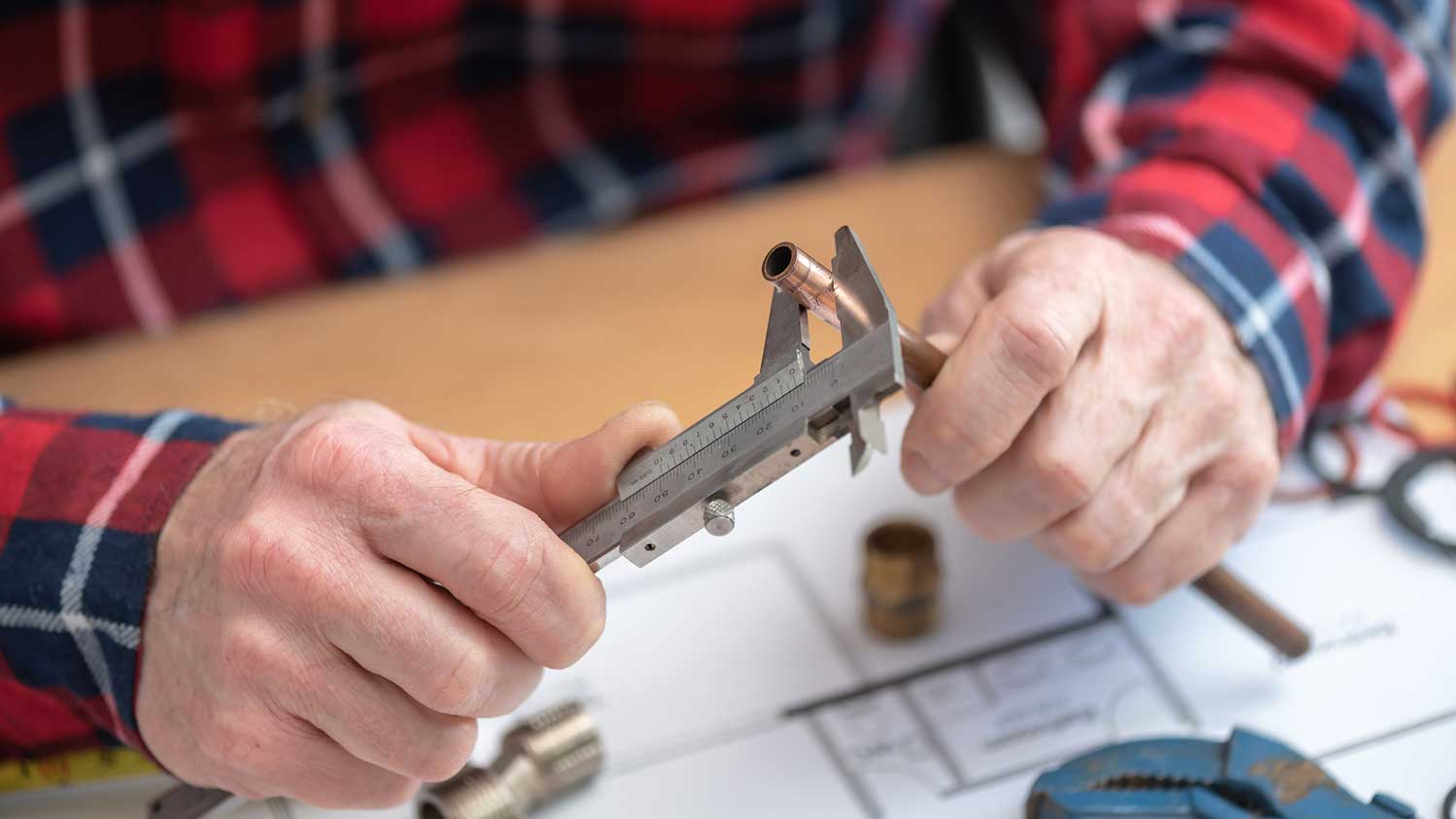How to Measure Pipe Size (With a Handy Pipe Size Conversion Chart)
Sometimes all it takes are calipers, other times you’ll need to do a little math


If you’re a handy DIYer with a plumbing project on the horizon, you might need to know how to measure pipe sizes. Did you know the diameter of a pipe isn’t always reflected in the name? For example, the outside diameter of a 1-inch copper pipe isn’t 1 inch—it’s slightly larger. Don’t worry, though. This guide will show you how to measure pipe size, so you don’t accidentally end up with a bad DIY job or wasted materials and money.
What to Know Before Measuring Your Pipe Size
You’ll only need to put aside about half an hour for this simple project. As far as tools, all you’ll need is a soft measuring tape, a caliper, and a calculator (and your pipe, of course).
When you’re measuring a pipe, the outside diameter (the number you get from your measurement) correlates with a nominal pipe size (the size sold in hardware stores). For example, a 1/2-inch copper pipe has an outside diameter of 5/8 of an inch.
If your pipe is smaller than 14 inches—all pipes in your home should be—you can use an online chart to convert your measurement into the pipe size. The conversion depends on the type of pipe. Some plastic pipes have different wall thicknesses and different measurements, but you can usually check the size on the pipe itself.
Note: You will not need to convert the outside diameter to a nominal pipe size if your pipe is 14 inches or more in diameter or you’re using tubing instead of piping. In this case, these figures should be the same. If you’re using PEX or cross-linked polyethylene tubing, the nominal size simply refers to the outside diameter.
Copper Pipes Size Conversion Chart
| Nominal Pipe Size | Outside Diameter Measurement (Fraction) | Outside Diameter Measurement (Decimal) |
|---|---|---|
| 1/2" | 5/8" | 15.875 mm |
| 3/4" | 7/8" | 22.225 mm |
| 1" | 1 1/8" | 28.575 mm |
| 1 1/4" | 1 3/8" | 34.935 mm |
| 1 1/2" | 1 1/2" | 41.275 mm |
| 2" | 2 1/8" | 53.975 mm |
| 3" | 3 1/8" | 79.375 mm |
| 4" | 4 1/8" | 104.775 mm |
PVC, Stainless Steel, or Brass Pipes Size Conversion Chart
| Nominal Pipe Size | Outside Diameter Measurement (Fraction) | Outside Diameter Measurement (Decimal) |
|---|---|---|
| 1/2" | 27/32" | 21.336 mm |
| 3/4" | 1 3/64" | 26.67 mm |
| 1" | 1 5/16" | 33.401 mm |
| 1 1/4" | 1 23/32" | 42.164 mm |
| 1 1/2" | 1 29/32" | 48.26 mm |
| 2" | 2 3/8" | 60.325 mm |
| 3" | 3 1/2" | 88.90 mm |
| 4" | 4 1/2" | 114.3 mm |
How to Measure Pipe Size
Here’s what you’ll need to do to get accurate measurements on your pipes.
1. Check the Pipe for a Number

Before you bother with a measurement, inspect the outside of the pipe. Some pipes—especially PVC, CPVC, or PEX pipes—are labeled with the size on the side. This step can save you a ton of work because that number refers to the outside diameter, in which case, you’re done!
Pipes made out of copper, iron, steel, and other materials won’t have these labels, so you’ll need to measure them yourself.
2. Determine the Type of Pipe

Before you can measure your pipe, you need to know which kind you’re dealing with. There are three types of pipes:
Male pipes: The pipe either has grooves on the outside, which help it fit into a female pipe, or it’s simply thinner than the female end into which it fits. You’ll see these in drain pipes, on things like backflow preventers and water meters, and on connections to fixtures.
Female pipes: The pipe either has grooves on the inside, which help it grip a male pipe, or the inside diameter is the same as the male pipe’s outside diameter, as in the case of a drain pipe. Female pipes are common in drain pipes, on plumbing supply lines, and on connections to appliances and fixtures, including water heaters.
No thread pipes: Pipes are smooth on each end with no grooves.
You’ll measure female pipes a little differently.
3. Measure Your Male or No-Thread Pipe

If your pipe is still connected to the plumbing without an exposed edge, there are two ways you can measure a male pipe or no-thread pipe. Either use a caliper or a soft tape measure. A caliper measurement requires a little less math.
Using a Caliper
Fit a caliper around the outside of the pipe to get an outside diameter measurement. Record the measurement.
Using a Soft Measuring Tape
Measure the pipe’s circumference by wrapping a soft tape measure around its outside circumference. Divide the circumference measurement by pi (3.1415) to get the outside diameter.
4. Measure Your Female Pipe

For a female pipe, you’ll actually need to measure the inside diameter instead of the outside diameter. In layman’s terms, that’s the width of the pipe hole, excluding the thickness of the pipe walls. Use your caliper to measure the distance between one inside edge of the pipe to the other inside edge of the pipe.
Unfortunately, there’s no convenient way to measure inside pipe diameter without calipers. You can use a ruler or tape measure, but the measurement won’t be as precise.
5. Convert the Diameter to the Nominal Size
To get the nominal pipe size (the size you can buy in the store), you’ll need to convert your diameter measurement. Remember, you should use an outside diameter for male or no-thread pipes, but you’ll use an inside diameter for female pipes. You can use one of the charts above to make the conversion. If you’re unsure or have a different pipe material, you can find a specific table online or default to the manufacturer.
Should You DIY Pipe Measurements?
Most people can measure their own pipes, especially if it’s a common type of pipe. And you can save some money on the cost of a plumber if you successfully measure your pipes and buy the materials yourself for a plumbing repair.
With that being said, it can get a little confusing for those who aren’t familiar with plumbing or those who have less common pipes. There are all different pipe sizing standards, from copper tube sizing (CTS) to the iron pipe standard (IPS), and each has a different size conversion chart—and that’s before you dive into the thickness of the pipe wall you’re measuring, which can also vary among types of plumbing pipes.
At best, if your measurements are incorrect, you can make a correction and swap out the wrong size with the right size—all it will cost you is an additional trip to the home improvement store. At worst, installing the wrong size pipe can lead to expensive water damage repairs, leaky faucets, or slow drains. Provided you hire a plumber or vetted faucet repair service near you to get the actual repair done, though, you’ll know for sure if you got the right size, as your professional will let you know.
Frequently Asked Questions
In the best-case scenario, the pipe size is written on the side of the pipe. You’ll often find this with different types of plastic piping like PVC, PEX, or CPVC. For other types of pipes, you’ll have to measure. Typically, you can measure the outside circumference with a soft tape measure, then divide your measurement by pi. From there, you’ll have to use a conversion chart to get the nominal pipe size (the size you’d buy in the store).
The size of a pipe isn’t always the outside or inside diameter. Rather, it’s a nominal diameter that depends on the type of pipe. For male pipes, you’ll need to measure the outside diameter. For female pipes, you’ll need to measure the inside diameter. You’ll then need to use a nominal diameter conversion chart to get the actual pipe size you’d buy in the store.
To measure pipe size, you can use a ruler, a soft tape measure, or a caliper. Sometimes you can even find a special pipe caliper that has iron or copper pipe sizes already marked. Rulers work if the end of the pipe is exposed. If your pipe is still attached to the plumbing, you’ll need to go for a soft tape measure or caliper.
In North America, pipe measurements are usually listed as the nominal pipe size (NPS). This measurement refers to the outside diameter. As an example, a 1/2-inch chopper pipe has an outside diameter of 5/8 of an inch. If a hardware store lists a pipe as having a 2 NPS, it means that all the pipes with this measurement have a 2 and ⅜-inch outside diameter, regardless of wall thickness and inside diameter.
Yes. There are a variety of standard pipe sizes used in plumbing. The main supply line connecting your home to the street is either 3/4 or 1 inch in diameter. Supply lines are 3/4 inch in diameter. Individual components are 1/2 inch in diameter. Meanwhile, your main drain pipe is often 4 inches wide. Most shower and bathtub drains are 2 inches in diameter, most toilet drains are 3 inches in diameter, and most sink drains are one-and-a-quarter or one-and-a-half inches in diameter.





- Gas Plumbers
- Plumbing Repairs
- Sump Pump Installation
- Wood & Pellet Stove Repair
- Shower Repair
- Wood Stove Services
- Emergency Plumbers
- Fire Sprinkler Contractors
- Perc Test Companies
- Toilet Repair & Installation
- Boiler Repair
- Sewer Line Repair
- Faucet Repair
- Main Drain Camera Companies
- Foundation Drain Installation
- French Drains
- Bathtub Replacement
- Subcontractors
- Storm Drain Contractors
- Affordable Plumbing
- Plumbing & Heating Companies
- Bathroom Repair Services
- Sink Installation
- Commercial Plumber
- Barndominium Builders
- Water Line Repair
- Faucet Installation
- Water Line Installation
- Leak Detection
- 7 Ways to Fix a Copper Pipe Leak: Temporary and Long-Term Solutions
- 6 Temporary Fixes for Leaking Pipes
- How to Tell if a Pipe Bursts in Your House Before Water Takes Its Toll
- How to Glue PVC Pipes Together So They’re Watertight
- How to Cut PVC Pipe: The 3 Most Common Methods
- Is Pipe Insulation Worth It?
- How to Vent a Toilet, Sink, and Shower
- 5 Pipe Clamp Types and How to Pick the Best One for Your Project
- Well Water Frozen? Try These Hacks to Fix Frozen Well Water Pipes
- Copper Pipes vs. PVC Pipes: What Are the Key Differences?










